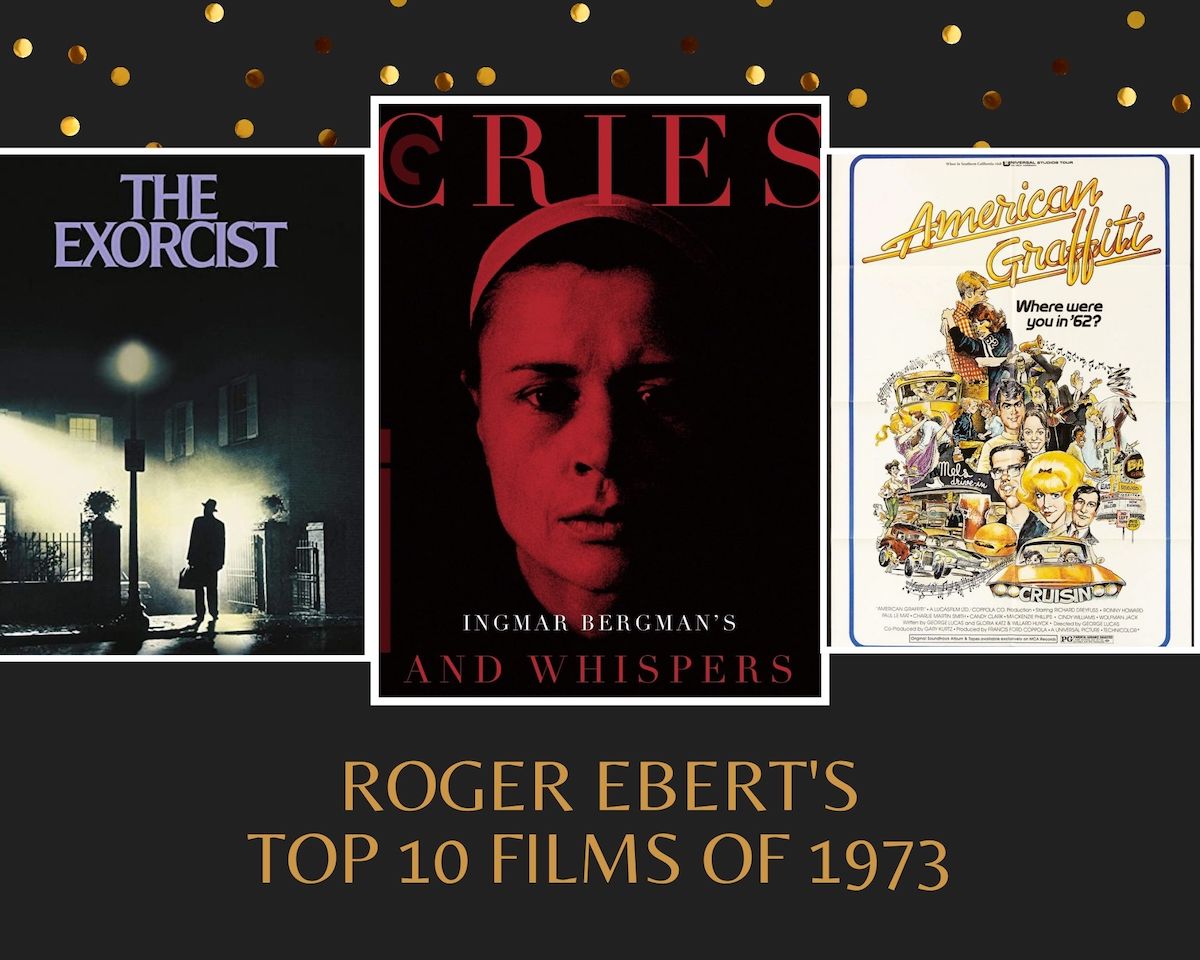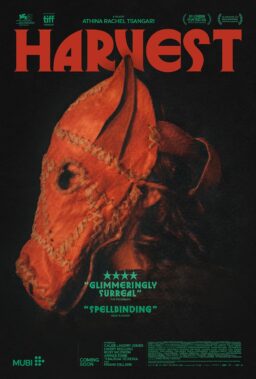We continue celebrating this site’s co-founder, Roger Ebert, by publishing some of his invaluable lists ranking the Top Ten films from particular years over the past half-century. Today we will start with his Top Ten List from 1973, containing the classic film “The Exorcist.” We will not publish every list, but as the week goes on we will publish selective years and even decades.
Click on the title of each film, and you will be directed to the full review…
ROGER EBERT’S TOP TEN FILMS OF 1973

10. THE FRIENDS OF EDDIE COYLE
“The Friends of Eddie Coyle” works so well because Eddie is played by Robert Mitchum, and Mitchum has perhaps never been better. He has always been one of our best screen actors: sardonic, masculine, quick-witted, but slow to reveal himself. He has never been in an absolutely great film; he doesn’t have masterpieces behind him like Brando or Cary Grant. More than half his films have been conventional action melodramas, and it is a rare summer without at least one movie in which Mitchum wears a sombrero and lights bombs with his cigar. But give him a character and the room to develop it, and what he does is wonderful. Eddie Coyle is made for him: a weary middle-aged man, but tough and proud; a man who has been hurt too often in life not to respect pain; a man who will take chances to protect his own territory.

9. FELLINI’S ROMA
“Fellini’s Roma” was attacked in some circles as an example of Fellini coasting on his genius. I find this point of view completely incomprehensible. Critics who would force Fellini back into traditional narrative films are missing the point; Fellini isn’t just giving us a lot of flashy scenes, he’s building a narrative that has a city for its protagonist instead of a single character. The only sly thing is that the city isn’t Rome, it’s Fellini, disguised in bricks, mortar, and ruins. Fellini, who cannot find his way between the flesh and the spirit, who cannot find the connection between his youth and his greatness, and whose gift is to make movies where everything is obvious and nothing is simple. That was the dilemma that the Fellini character faced in “8 1/2”, when he couldn’t make sense of his life, and it’s the dilemma we all face every day, isn’t it?

8. AMERICAN GRAFFITI
On the surface, Lucas has made a film that seems almost artless; his teenagers cruise Main Street and stop at Mel’s Drive-In and listen to Wolfman Jack on the radio and neck and lay rubber and almost convince themselves their moment will last forever. But the film’s buried structure shows an innocence in the process of being lost, and as its symbol Lucas provides the elusive blonde in the white Thunderbird — the vision of beauty always glimpsed at the next intersection, the end of the next street. Who is she? And did she really whisper “I love you” at the last traffic signal? In “8 1/2,” Fellini used Claudia Cardinale as his mysterious angel in white, and the image remains one of his best; but George Lucas knows that for one brief afternoon of American history angels drove Thunderbirds and could possibly be found at Mel’s Drive-In tonight… or maybe tomorrow night, or the night after.

7. THE DAY OF THE JACKAL
Fred Zinnemann’s “The Day of the Jackal” is one hell of an exciting movie. I wasn’t prepared for how good it really is: it’s not just a suspense classic, but a beautifully executed example of filmmaking. It’s put together like a fine watch. The screenplay meticulously assembles an incredible array of material, and then Zinnemann choreographs it so that the story–complicated as it is–unfolds in almost documentary starkness.

6. THE EXORCIST
It may be that the times we live in have prepared us for this movie. And Friedkin has admittedly given us a good one. I’ve always preferred a generic approach to film criticism; I ask myself how good a movie is of its type. “The Exorcist” is one of the best movies of its type ever made; it not only transcends the genre of terror, horror, and the supernatural, but it transcends such serious, ambitious efforts in the same direction as Roman Polanski’s “Rosemary’s Baby.” Carl Dreyer’s “The Passion of Joan of Arc” is a greater film–but, of course, not nearly so willing to exploit the ways film can manipulate feeling.

5. THE ICEMAN COMETH
There isn’t a bad performance in the film, but there are three of such greatness they mesmerize us. The best is by the late Robert Ryan, as Larry, and this is possibly the finest performance of his career. There is such wisdom and sadness in his eyes, and such pain in his rejection of the boy Don (who may possibly be his own son), that he makes the role almost tender despite the language O’Neill gives him. It would be a tribute to a distinguished career if Ryan were nominated posthumously for an Academy Award. Lee Marvin, as Hickey, has a more virtuoso role: He plays a salesman who has been coming to Harry’s saloon for many years to have a “periodical drunk.” This time he’s on the wagon, he says, because he’s found peace. We discover his horrible peace when he confesses to the murder. Marvin has recently been playing in violent action movies that require mostly that he look mean; here he is a tortured madman hidden beneath a true believer.

4. BLUME IN LOVE
With “Blume in Love,” Mazursky seems to have pulled off what everybody is always hoping for from Neil Simon: a comedy that transcends its funny moments, that realizes we laugh so we may not cry, and that finally is about real people with real desperations. He’s done that in a number of scenes, and yet somehow even during the movie’s gloomiest moments he keeps some sort of hope alive. That’s probably because Blume is played by the charming George Segal, who seems intrinsically optimistic. No matter what Nina says, he cannot quite give up on her, because he knows she must eventually love him again-because he loves her.

3. THE EMIGRANTS
Troell’s epic film, more than 2 1/2 hours long and infinitely absorbing and moving, is based upon “Upon a Good Land,” the best-selling series of Swedish novels by Vilhelm Moberg. At nearly $2 million, this is the most expensive and ambitious Swedish film ever made and one of the handful of foreign films ever to be shot partly on location in America. (Troell used the Great Lakes, Minnesota, northern Wisconsin – and Galena.) It tells the story of Swedish immigrants but it might as well be about any group of people. The voyage would have been just as long, the illnesses and deaths just as heartbreaking, the spirit as indomitable.

2. LAST TANGO IN PARIS
The movie may not contain Brando’s greatest performance, but it certainly contains his most emotionally overwhelming scene. He comes back to the hotel and confronts his wife’s dead body, laid out in a casket, and he speaks to her with words of absolute hatred — words which, as he says them, become one of the most moving speeches of love I can imagine. As he weeps, as he attempts to remove her cosmetic death mask (“Look at you! You’re a monument to your mother! You never wore makeup, never wore false eyelashes!”), he makes it absolutely clear why he is the best film actor of all time. He may be a bore, he may be a creep, he may act childish about the Academy Awards — but there is no one else who could have played that scene flat-out, no holds barred, the way he did, and make it work triumphantly.

1. CRIES AND WHISPERS
“Cries and Whispers” is like no movie I’ve seen before, and like no movie Ingmar Bergman has made before; although we are all likely to see many films in our lives, there will be few like this one. It is hypnotic, disturbing, frightening. It envelops us in a red membrane of passion and fear, and in some way that I do not fully understand it employs taboos and ancient superstitions to make its effect. We slip lower in our seats, feeling claustrophobia and sexual disquiet, realizing that we have been surrounded by the vision of a film maker who has absolute mastery of his art. “Cries and Whispers” is about dying, love, sexual passion, hatred and death – in that order.











